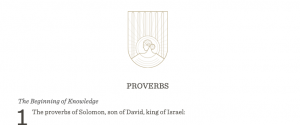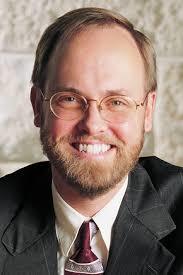Justin Taylor's Blog, page 25
April 20, 2019
A Poem for Holy Saturday: George Herbert’s “Sepulchre”

George Herbert (1633):
Oh blessed body! Whither art thou thrown?
No lodging for thee, but a cold hard stone?
So many hearts on earth, and yet not one
Receive thee?
Sure there is room within our hearts good store;
For they can lodge transgressions by the score:
Thousands of toys dwell there, yet out of door
They leave thee.
But that which shows them large, shows them unfit.
Whatever sin did this pure rock commit,
Which holds thee now? Who hath indicted it
Of murder?
Where our hard hearts have took up stones to brain thee,
And missing this, most falsely did arraign thee;
Only these stones in quiet entertain thee,
And order.
And as of old, the law by heav’nly art,
Was writ in stone; so thou, which also art
The letter of the word, find’st no fit heart
To hold thee.
Yet do we still persist as we began,
And so should perish, but that nothing can,
Though it be cold, hard, foul, from loving man
Withhold thee.
In his book, A Year with George Herbert: A Guide to Fifty-Two of His Best Loved Poems, Jim Scott Orrick identifies the thesis of this poem as follows:
Our hearts are as cold and hard as stone, but stone cannot prevent Christ from loving us.
Professor Orrick provides a paraphrase and some contextual notes for the poem as follows:
It is not for lack of room that human hearts refuse to receive Christ. We obviously have plenty of room; the horde of sins and worldly pleasures that dwell in our hearts demonstrate that we have room.
All those sins and worldly pleasures render our hearts unsuitable to receive Jesus.
This rock [the sepulchre] has committed no sins.
We, on the other hand, have attempted to kill you with stones. [Cf. John 10:31]
(The recollection of the frenzied mob at Jesus’ trial renders the silence and order of the tomb all the more profound.)
(The Ten Commandments were written in stone by the finger of God.)
As under the Old Covenant the word of God was held in stone, so now you, the Word of God incarnate, are held in stone.
Human hearts continue to be as hard as those that rejected you during the days of your incarnation, and this hardness of heart would continue in us and ultimately condemn us if it were not for your rock-smashing love.
This sepulchre, though made of stone, cannot hold you in, and human heart, though also stony, cannot keep you out.
April 19, 2019
A Beautiful Biblical Theology of the Passover in Song

Caroline Cobb and Sean Carter provide a great example of biblical theology through song, from the album The Blood + the Breath: Songs That Tell the Story of Redemption:
There’s a promise in our veins
But it’s faded by all these years in chains
Send a prophet, send the plagues
That by sunrise we will no more be slaves
Take the lamb, take the blood
And paint it on our doorways
At night death will come but pass us by
This is all our hope and peace
In the morning we will rise
Taste the freedom we thought we’d never find
We will dance now in the streets
Once held captive now we shall live as kings
Lift your head, your voice
And sing of your salvation
Of the blood of the lamb that gave us life
Now by this we’ll overcome
Now by this we’ll reach our home
There’s a poison in our veins
And it leads to death we cannot escape
Send a ransom a perfect Son
Remedy the curse with His precious blood
And the Lamb that will come
His cross will be our doorway
And the red of His blood will make us white
And daughters and sons
Rejoice in resurrection
And death swallowed up in endless life
Glory, glory this I sing
All my praise for this I bring
Naught of good that I have done
Nothing but the blood of Jesus
“The Passover Song (Feat. Sean Carter)”
Words and music by Caroline Cobb (ASCAP) and Sean Carter
Copyright 2013 Caroline Cobb Smith, Sean Carter.
Written January 11–14, 2013
Exodus 12 (The Passover in Egypt; see also John 1:29; Hebrew 10:20)
Is He Worthy?

Andrew Peterson asks, “Is he worthy?
We respond: “He is.”
And I saw a mighty angel proclaiming with a loud voice, “Who is worthy to open the scroll and break its seals?”
And no one in heaven or on earth or under the earth was able to open the scroll or to look into it, and I began to weep loudly because no one was found worthy to open the scroll or to look into it.
And one of the elders said to me, “Weep no more; behold, the Lion of the tribe of Judah, the Root of David, has conquered, so that he can open the scroll and its seven seals.”
And between the throne and the four living creatures and among the elders I saw a Lamb standing, as though it had been slain, with seven horns and with seven eyes, which are the seven spirits of God sent out into all the earth.
And he went and took the scroll from the right hand of him who was seated on the throne.
And when he had taken the scroll, the four living creatures and the twenty-four elders fell down before the Lamb, each holding a harp, and golden bowls full of incense, which are the prayers of the saints.
And they sang a new song, saying,
“Worthy are you to take the scroll
and to open its seals,
for you were slain, and by your blood you ransomed people for God
from every tribe and language and people and nation,
and you have made them a kingdom and priests to our God,
and they shall reign on the earth.”
Then I looked, and I heard around the throne and the living creatures and the elders the voice of many angels, numbering myriads of myriads and thousands of thousands, saying with a loud voice,
“Worthy is the Lamb who was slain,
to receive power and wealth and wisdom and might
and honor and glory and blessing!”
—Revelation 5:1–12
April 18, 2019
What Hour Was Jesus Crucified? Resolving an Apparent Bible Contradiction

According to the Gospel of Mark, Jesus was crucified on the “third hour” (Mark 15:25).
The Gospel of John, however, says Pilate sentenced Jesus to crucifixion on “about the sixth hour” (John 19:14).
In a book I worked on with Andreas Köstenberger and Alexander Stewart, we addressed what is going on here and why this is not a contraction.
To answer this, we have to review some basics about how “time” was thought of in the first-century Mediterranean world. If we don’t, it is easy to become anachronistic and to import or insist upon levels of precision that were not in operation in the original context.
How Jews Understood Time in the Day and Night
First, we should bear in mind that in the Western world we are extremely time conscious, keep tracking of time down to the second.
But as Johnny V. Miller writes,
Time notations from the time of Christ and before were very inexact, bearing little or no resemblance to the modern concept of punctuality.
Sundials were not in common use in the first century, and there was no unit of time used smaller than the “hour.”
Second, Jews thought of a day—from sunrise to sunset—as represented by “12 hours.”
As Jesus asks his disciples rhetorically, “Are there not twelve hours in the day?” (John 11:9).
Third, Jews usually divided the day with three reference points.
In Jesus’s parable of the vineyard and the laborers he refers to
“the third hour [from sunrise],”
“the sixth hour [from sunrise],” and
the “ninth hour [from sunrise]” (Matt. 20:1-9).
These were general references for, respectively:
mid-morning,
mid-day, and
mid-afternoon.
These are the only time markers listed in the crucifixion accounts (Matt. 27:45; Mark 15:25, 33; Luke 23:44; John 19:14).
Fourth, we see something analogous with how a first-century Roman or Jew would understand the night.
When discussing his impending return, Jesus commands his disciples to stay awake, “for you do not know when the master of the house will come, in the evening, or at midnight, or when the rooster crows, or in the morning” (Mark 13:35).
Here we see “night”—from sunset to sunrise—divided into four watches:
evening,
midnight,
rooster-crow, and
morning.
Kevin Lipp produced for us this helpful visual aid:
What Is Going on in Mark 15:25 and John 19:14?
When we come to passage like Mark 15:25, it is probably best to understand the expression “the third hour” not as a precise reference to 9 a.m., but as an approximate reference to midmorning—from 7:30 or 8 a.m. until 10 or 10:30 a.m.
Likewise, the “sixth hour” could refer to any time from 10:30 a.m. or 11 a.m to 1 p.m. or 1:30 p.m. (Remember that the “hours” were rough approximations of the sun’s position in a quadrant of the sky.)
If the sentencing was delivered, say, around 10:30 a.m., and two witnesses were to glance at the sun in the sky, one could round down to the “third hour” and one could round up to “about the sixth hour,” depending on other factors they might want to emphasize (for example, if John wants to highlight in particular the length of the proceedings and that the final verdict concerning the Lamb of God is not far off from the noontime slaughter of lambs for the Sabbath dinner of Passover week).
Ultimately, there is no final contradiction, especially given the fact that John gives an approximation (“about”) of something that was not meant to be precise in the first place.
April 12, 2019
The Different Types of Characters in the Book of Proverbs

The introduction to the book of Proverbs in the ESV Study Bible notes that the characters in the book usually serve as idealized portraits.
In other words:
They denote people exemplary for their virtue and wisdom or especially despicable for their evil. The literary name for this is “caricature”: portraits of people with features exaggerated for easy identification.
The positive figures serve as ideals for the faithful, to guide their conduct and character formation.
The negative figures are exaggerated portraits of those who do not embrace the covenant, so the faithful can recognize these traits in themselves and flee them.
“To read Proverbs well,” the introduction notes, “one must have a good grasp of who the character types are and what function they serve in the book.”
It then identifies the three most obvious characters in the book: the wise, the fool, and the simple.
[1. The Wise]
Proverbs urges its readers to be wise, that is, to embrace God’s covenant and to learn the skill of living out the covenant in everyday situations (cf. Prov. 2:2).
The wise person has done that (cf. Prov. 10:1); usually Proverbs focuses on the one who has made good progress in that skill, whose example is worth following (cf. Prov. 9:8b).
[2. The Fool]
The fool is the person steadily opposed to God’s covenant (cf. Prov. 1:7b).
The setting of Proverbs assumes there can be fools even among God’s people.
There are three Hebrew terms translated “fool” (kesil, ’ewil, nabal), with little difference among them.
This kind of person resists even the offer of forgiveness found in the covenant (Prov. 14:9; 15:8).
These people are dangerous in their influence (Prov. 13:20; 17:12) and cause grief to their parents (Prov. 10:1); but they are not beyond hope (Prov. 8:5).
[3. The Simple]
The simple is the person who is not firmly committed, either to wisdom or to folly; he is easily misled (cf. Prov. 14:15).
His trouble is that he does not apply himself to the discipline needed to gain and grow in wisdom.
The introduction goes on to provide three additional categories for the characters.
[4. Co-Referential Characters from Different Positive Angles]
Proverbs also uses other terms, both positive (e.g., righteous, upright, diligent, understanding, prudent) and negative (e.g., wicked, lazy, lacking sense).
These do not designate different groups of people from the wise and the fools; rather, the terms are commonly “co-referential,” i.e., they apply to the same people looked at from different angles.
The righteous is the one who has embraced the covenant, seen from the perspective of his faithfulness to God’s will;
the wise is the same person, seen from the perspective of his skill in living out God’s will;
the prudent is the same individual seen as one who carefully plans out his obedience.
[5. Co-Referential Characters Different Negative Angles]
Likewise, the wicked is the one who rejects God’s covenant, seen from the angle of his opposition to God;
the fool is this same person, seen from the angle of the stupid course of life he has chosen.
The co-referential use of these terms helps the reader to discern the many-sided fruits of godliness and ungodliness.
[6. Gradations of Negative Characters]
Beyond the co-referential negative terms, there are some gradations.
The scoffer is worse than a fool (21:24).
The person wise in his own eyes is almost beyond hope (cf. 26:12). The difference is one of hardness in unteachability (the great sin in Proverbs).
The simple is not as far gone as the fool.
All of these are what the OT calls “uncircumcised” in heart, and what Christian theology calls “unregenerate.”
April 5, 2019
Douglas A. Sweeney Named the New Dean at Beeson Divinity School

Douglas Sweeney has been named the new dean of Beeson Divinity School at Samford University in Birmingham, Alabama, succeeding the school’s founding dean, Timothy George, who had served in the position since the school’s inception in 1988. (You can read Collin Hansen’s appreciation of Timothy George over at the TGC main page.)
 Dr. Sweeney and his wife, Wilma, currently reside with their son, David, in Lindenhurst, Illinois, where they are members of St. Mark Lutheran Church.
Dr. Sweeney and his wife, Wilma, currently reside with their son, David, in Lindenhurst, Illinois, where they are members of St. Mark Lutheran Church.
Sweeney received his BA in history from Wheaton College in 1986, an MA in the history of Christian thought from Trinity Evangelical Divinity School in 1989, and then an MA in religion at Vanderbilt University, where he also received his PhD in religion in 1995.
From 1995 to 1997 he served at Yale University, where he edited The Works of Jonathan Edwards and lectured in church history and historical theology.
In 1997, he returned to his alma mater of Trinity Evangelical Divinity School, where he has served until now, rising through the ranks:
Assistant Professor of Church History and the History of Christian Thought (1997–2002)
Associate Professor of Church History and the History of Christian Thought (2002–2008)
Professor of Church History and the History of Christian Thought (2008–2017)
Distinguished Professor of Church History and the History of Christian Thought (2017–2019)
Chair of the Department of Church History and the History of Christian Thought (2001–2005; 2012–2019)
Director of the Carl F. H. Henry Center for Theological Understanding (2000–2012)
Director of the Jonathan Edwards Center (2010–2019)
Sweeney is one of the world’s leading experts on the life and work of Jonathan Edwards.
His books on Edwards include:
The Sermons of Jonathan Edwards: A Reader (Yale University Press, 1999), edited with Wilson Kimnach and Kenneth Minkema
Nathaniel Taylor, New Haven Theology, and the Legacy of Jonathan Edwards (Oxford University Press, 2003)
Jonathan Edwards, “Miscellanies” Nos. 1153–1360, The Works of Jonathan Edwards, vol. 23 (Yale University Press, 2003)
Jonathan Edwards at Home and Abroad: Historical Memories, Cultural Movements, Global Horizons (University of South Carolina Press, 2003), edited with David Kling
The New England Theology: From Jonathan Edwards to Edwards Amasa Park (Baker Academic, 2006), edited with Allen Guelzo
Jonathan Edwards and the Ministry of the Word (IVP Academic, 2009)
The Essential Edwards Collection (Moody, 2010), co-written with Owen Strachan
After Jonathan Edwards: The Courses of the New England Theology (Oxford University Press, 2012), edited with Oliver Crisp
Edwards the Exegete: Biblical Interpretation and Anglo-Protestant Culture on the Edge of the Enlightenment (Oxford University Press, 2016)
Jonathan Edwards and Scripture: Biblical Interpretation in British North America (Oxford University Press, 2018), edited with David Barshinger
The Oxford Handbook of Jonathan Edwards (Oxford University Press, forthcoming), edited with Oliver Crisp
Sweeney is currently President of the Conference on Faith and History.
In his book on Jonathan Edwards and the Ministry of the Word, Sweeney articulated seven things that Jonathan Edwards showed us about God, the world, and our lives:
Edwards shows us the importance of working to help people gain a vivid sense, an urgent impression, of God’s activity in our world.
Edwards shows us that true religion is primarily a matter of holy affections.
Edwards shows us the advantages of keeping an eschatological perspective on our lives.
Edwards shows us how God uses those who lose their lives for Christ.
Edwards shows us that theology can and should be done primarily in the church, by pastors, for the sake of the people of God.
Edwards shows us that even the strongest Christians need support from others.
Edwards shows us the necessity of remaining in God’s Word.
May the Lord bless this brilliant and humble man as he brings this perspective to his new role at leading Beeson Divinity School.
April 1, 2019
TGC 2019 Livestream Schedule for the Plenary Talks

All times Eastern, streamed live here.
Monday, April 1
1. 1:50–2:50 PM — John Piper, “Unashamed to Be Scorned with Jesus” (Mark 8:31–38)
2. 3:40–4:40 PM — Tim Keller, “You Must Be Born Again” (John 3:1–21)
3. 7:50–8:50 PM — Ligon Duncan, “A Pagan Woman Who Understands Grace” (Mark 7:24–30)
Tuesday, April 2
4. 9:30–10:30 AM — H. B. Charles, “The Woman at the Well” (John 4:1–42)
5. 11:10–12:10 AM — Kevin DeYoung, “Hometown Disadvantage” (Luke 4:14–37)
6. 8:15–9:15 PM — Trip Lee, “Healing and Faith” (Matthew 8:1–13)
Wednesday, April 3
7. 9:35–10:35 AM — David Platt, “Paralysis and Forgiveness” (Mark 2:1–12)
8. 11:10 AM–12:10 PM — D. A. Carson, “Lazarus” (John 11:1–53)
March 27, 2019
J. I. Packer on the 6 Things You Should Tell Yourself Every Day

Spiritual adoption is a big deal for the practical theology of J. I. Packer.
In Knowing God J. I. Packer writes:
If you want to judge how well a person understands Christianity, find out how much he makes of the thought of being God’s child, and having God as his Father.
If this is not the thought that prompts and controls his worship and prayers and his whole outlook on life, it means that he does not understand Christianity very well at all.
He says that if he were to focus the New Testament message in three words, he would choose
adoption through propitiation.
“I do not expect,” he writes, “ever to meet a richer or more pregnant summary of the gospel than that.”
How would Packer summarize the whole of New Testament teaching?
a revelation of the Fatherhood of the holy Creator.
He summarizes the whole of New Testament religion as
the knowledge of God as one’s holy Father.
He writes:
Everything that Christ taught,
everything that makes the New Testament new, and better than the Old,
everything that is distinctively Christian as opposed to merely Jewish,
is summed up in
the knowledge of the Fatherhood of God.
Packer says that each of us should ask ourselves the following questions:
Do I, as a Christian, understand myself?
Do I know my own real identity?
My own real destiny?
Calling this “the Christian’s secret of a Christian life and of a God-honoring life,” he says that we should take the following truths and “Say it over and over to yourself first thing in the morning, last thing at night, as your wait for the bus, any time your mind is free, and ask that you may be enabled to live as one who knows it is all utterly and completely true.”
I am a child of God.
God is my Father.
Heaven is my home.
Every day is one day nearer.
My Savior is my brother.
Every Christian is my brother too.
If you haven’t read Packer’s chapter on adoption in Knowing God, I highly recommend it.
D. A. Carson on 5 Reasons You Should Want to Learn from Vern Poythress on Genesis 1–3

The foreword by D. A. Carson to Vern Poythress’s new book, Interpreting Eden: A Guide to Faithfully Reading and Understanding Genesis 1–3 (Crossway, 2019).
Some topics are notoriously complex, and few, if any, are more complex than the doctrine of creation.
This complexity springs in large part from the wide array of disciplines that impinge on the topic:
exegesis of the opening chapters of Genesis and of other biblical passages that talk about creation;
questions of literary genre;
hermeneutical principles;
the interface between Scripture and contemporary science (with its many compartmentalized disciplines, from cosmology to thermodynamics to biology and geology);
reception theory, which wrestles with the history of the interpretation of these chapters across many centuries and even more cultures;
epistemology;
the implications of working with God-inspired texts;
the dogmatism of various theological cliques on the left hand and on the right;
the nature of history;
literary structure; and
the place of analogy when talking about God.
And that list is certainly not exhaustive, but merely suggestive.
Enter Vern Poythress.
1. A Lifetime of Intelligent Interdisciplinary Work
Not every New Testament scholar begins his academic career with a PhD in mathematics from Harvard or writes across an extraordinarily wide range of theological topics:
baptism,
science,
providence,
accommodation,
translation theory,
the Trinity,
inerrancy,
hermeneutics,
spiritual gifts,
literary genre,
typology,
eschatology,
apocalyptic,
sociology, and, of course,
creation.
In the more than forty years I have known him, Dr. Poythress has kept pushing back the frontiers in a widening range of important subjects: it is hard to keep up with all his work.
And that is the first reason why he is as qualified as anyone, and more qualified than most, to wrestle with what the Bible says about creation: he has spent his life interacting intelligently with many of the related fields. Indeed, informed readers will find echoes of some of his earlier work in this study, as the panoply of his previous efforts comes together in this combination of analysis and synthesis.
2. A Very High View of Scripture
3. A Subscription to Classical Confessionalism
The second and third reasons why Dr. Poythress is the person to write this work hang together: he simultaneously espouses a very high view of Scripture and classic confessionalism.
Some adopt the former but know little of the latter: they tend toward a mere proof-texting exegesis, unable to see the forest as they fasten on a knot in the third branch of the sixteenth tree from the right. One remembers the insight of Francis Schaeffer, writing forty-five years ago (in Genesis in Space and Time). He set out not to unpack everything he could possibly find in Genesis 1–11, but everything in those chapters that must be true for the rest of the Bible to be coherent and faithful. Dr. Poythress is not so restrictive, but he has a fine instinct for what is most important.
Others loudly avow their commitment to historic confessionalism, but are either unwilling or unable to engage in careful exegesis.
Dr. Poythress wants to hold these polarities together.
4. A Clear and Simple Style
The fourth reason that qualifies Dr. Poythress to write this work is that, despite the complexities and subtleties of the issues, he writes with rare clarity and simplicity.
5. An Extraordinarily Supple and Creative Mind
And finally, Dr. Poythress has an extraordinarily supple and creative mind.
Not infrequently, scholars who have been shaped by Reformed confessionalism can manage no more than the faithful articulation of that heritage (which, of course, is no small virtue), while scholars who owe intellectual allegiance to very little can put forward many stimulating and creative proposals even while they ride right off the range. But Dr. Poythress manages to maintain the theological “thickness” of a rich tradition while venturing unafraid into many creative suggestions and postures. That is one of the reasons why it is a delight to read what he writes: I am invariably stimulated, challenged, egged on to think my way again through something I mistakenly thought I understood adequately.
That is a large part of the valuable contribution that Vern Poythress makes in this work. I read him with pleasure not because I think he is always right, and therefore doing no more than reinforcing my biases, but because as far as I can see he is far more likely to be right than not, and in any case he stimulates me to think within the matrix of profoundly Christian commitments. In a few areas, I think he is wrong: for example, the way he sets up the weighted contributions of the divine author and the human author is bold, but finally unconvincing. But even where I think he is wrong, he teaches me to shore up my own position with more care.
Be that as it may, books that I can recommend because I agree with them have their own easy usefulness; books that I recommend because they wrestle in a highly informed and stimulating way with biblical texts, whether I agree with them or not, are even more useful. Take it up, and read.
March 26, 2019
Why Pro-Choice People Won’t Define What ‘Abortion’ Really Is (or Where It Leads)

The success of the contemporary pro-abortion-rights movement depends on at three two things: (1) retaining their reign within the most visible, powerful, and effective means of public communication (education, media, and the courts); (2) downplaying the ghastly nature of what they are really advocating; and (3) denying the logical outcome of their view that those with power are able to eliminate those who are weaker.
Princeton University’s Robert P. George recently addressed these last two points in a Facebook post:
Have you ever noticed that when an abortion is being performed and the baby emerges alive, we call it an “attempted” abortion, or a “botched” abortion, or a “failed” abortion.
That tells us something.
Abortion is not properly or adequately described or defined as “terminating a pregnancy,” as it is so often described or defined in pro-abortion apologetics (and by the majority in Roe v. Wade). After all, the delivery of the child, alive or dead, terminates the pregnancy. So terminating the pregnancy cannot be the proper description of the abortionist’s act. And that’s because “terminating the pregnancy” is not the abortionist’s precise objective.
To identify and state his precise objective (aim, purpose, goal) you need to bring someone else into the discussion, namely, the child in the womb (fetus, unborn baby, call her what you will).
An abortion is successful—and not merely attempted—when and only when the child is killed—made dead. If she emerges alive, the abortionist has failed, we have a botched abortion.
So to claim that there is a right to abortion is not merely to say that a woman has the right to “terminate the pregnancy” (or even “control her own body”); it is to claim that she is entitled to order the killing of the baby—to order the performance of an act on the child’s body (dismembering her, burning her with saline) to end her life, to make her dead.
Of course, clearheaded and candid abortion advocates acknowledge this. They admit that the “right” they believe in is no mere right to be free of an unwanted pregnancy. It is the right not to be a mother, not to have a living child out there in the world—the right, to state the matter bluntly, to a dead fetus.
But if that’s true, then of course it is impossible to say why there is anything wrong with killing the child post-partum.
And so the logic takes them to where the Democratic Party finds itself today.
It was in the cards all along.
Justin Taylor's Blog
- Justin Taylor's profile
- 44 followers




